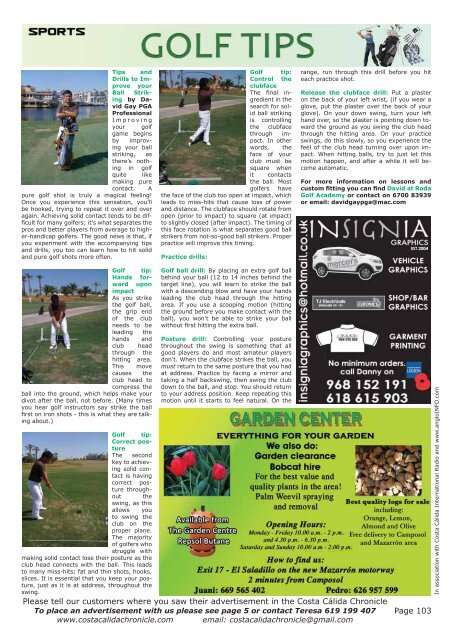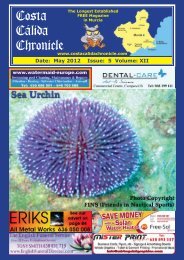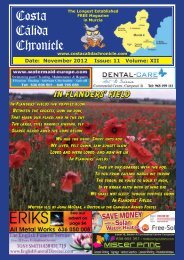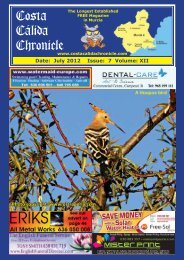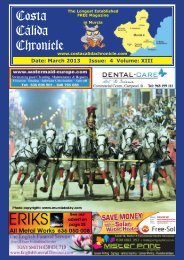Costa Cálida Chronicle - Costa Calida Chronicle
Costa Cálida Chronicle - Costa Calida Chronicle
Costa Cálida Chronicle - Costa Calida Chronicle
You also want an ePaper? Increase the reach of your titles
YUMPU automatically turns print PDFs into web optimized ePapers that Google loves.
Tips and<br />
Drills to Improve<br />
your<br />
Ball Striking<br />
by David<br />
Gay PGA<br />
Professional<br />
Improving<br />
your golf<br />
game begins<br />
by improving<br />
your ball<br />
striking, as<br />
there’s nothing<br />
in golf<br />
quite like<br />
making pure<br />
contact. A<br />
pure golf shot is truly a magical feeling!<br />
Once you experience this sensation, you’ll<br />
be hooked, trying to repeat it over and over<br />
again. Achieving solid contact tends to be difficult<br />
for many golfers; it’s what separates the<br />
pros and better players from average to higher-handicap<br />
golfers. The good news is that, if<br />
you experiment with the accompanying tips<br />
and drills, you too can learn how to hit solid<br />
and pure golf shots more often.<br />
Golf tip:<br />
Control the<br />
clubface<br />
The final ingredient<br />
in the<br />
search for solid<br />
ball striking<br />
is controlling<br />
the clubface<br />
through impact.<br />
In other<br />
words, the<br />
face of your<br />
club must be<br />
square when<br />
it contacts<br />
the ball. Most<br />
golfers have<br />
the face of the club too open at impact, which<br />
leads to miss-hits that cause loss of power<br />
and distance. The clubface should rotate from<br />
open (prior to impact) to square (at impact)<br />
to slightly closed (after impact). The timing of<br />
this face rotation is what separates good ball<br />
strikers from not-so-good ball strikers. Proper<br />
practice will improve this timing.<br />
Practice drills:<br />
range, run through this drill before you hit<br />
each practice shot.<br />
Release the clubface drill: Put a plaster<br />
on the back of your left wrist, (if you wear a<br />
glove, put the plaster over the back of your<br />
glove). On your down swing, turn your left<br />
hand over, so the plaster is pointing down toward<br />
the ground as you swing the club head<br />
through the hitting area. On your practice<br />
swings, do this slowly, so you experience the<br />
feel of the club head turning over upon impact.<br />
When hitting balls, try to just let this<br />
motion happen, and after a while it will become<br />
automatic.<br />
For more information on lessons and<br />
custom fitting you can find David at Roda<br />
Golf Academy or contact on 6700 83939<br />
or email: davidgaypga@mac.com<br />
Golf tip:<br />
Hands forward<br />
upon<br />
impact<br />
As you strike<br />
the golf ball,<br />
the grip end<br />
of the club<br />
needs to be<br />
leading the<br />
hands and<br />
club head<br />
through the<br />
hitting area.<br />
This move<br />
causes the<br />
club head to<br />
compress the<br />
ball into the ground, which helps make your<br />
divot after the ball, not before. (Many times<br />
you hear golf instructors say strike the ball<br />
first on iron shots - this is what they are talking<br />
about.)<br />
Golf tip:<br />
Correct posture<br />
The second<br />
key to achieving<br />
solid contact<br />
is having<br />
correct posture<br />
throughout<br />
the<br />
swing, as this<br />
allows you<br />
to swing the<br />
club on the<br />
proper plane.<br />
The majority<br />
of golfers who<br />
struggle with<br />
making solid contact lose their posture as the<br />
club head connects with the ball. This leads<br />
to many miss-hits; fat and thin shots, hooks,<br />
slices. It is essential that you keep your posture,<br />
just as it is at address, throughout the<br />
swing.<br />
Golf ball drill: By placing an extra golf ball<br />
behind your ball (12 to 14 inches behind the<br />
target line), you will learn to strike the ball<br />
with a descending blow and have your hands<br />
leading the club head through the hitting<br />
area. If you use a scooping motion (hitting<br />
the ground before you make contact with the<br />
ball), you won’t be able to strike your ball<br />
without first hitting the extra ball.<br />
Posture drill: Controlling your posture<br />
throughout the swing is something that all<br />
good players do and most amateur players<br />
don’t. When the clubface strikes the ball, you<br />
must return to the same posture that you had<br />
at address. Practice by facing a mirror and<br />
taking a half backswing, then swing the club<br />
down to the ball, and stop. You should return<br />
to your address position. Keep repeating this<br />
motion until it starts to feel natural. On the<br />
Please tell our customers where you saw their advertisement in the <strong>Costa</strong> Cálida <strong>Chronicle</strong><br />
To place an advertisement with us please see page 5 or contact Teresa 619 199 407<br />
www.costacalidachronicle.com email: costacalidachronicle@gmail.com<br />
Page 103<br />
In association with <strong>Costa</strong> Cálida International Radio and www.angloINFO.com


